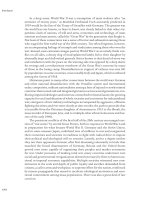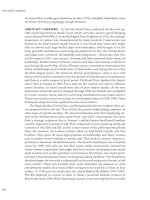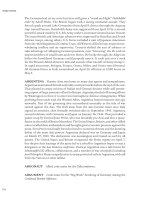Atlas of world war ii
Bạn đang xem bản rút gọn của tài liệu. Xem và tải ngay bản đầy đủ của tài liệu tại đây (36.74 MB, 192 trang )
Tai Lieu Chat Luong
Copyright © 1985 Brompton Books Corp
This edition published by Barnes & Noble, Inc.,
by arrangement with Brompton Books Corp.
2000 Barnes & Noble Books
All rights reserved. No part of this publication
may be reproduced, stored in a retrieval
system or transmitted in any form by any
means, electronic, mechanical, photocopying
or otherwise, without first obtaining written
permission of the copyright owner.
Printed in China
Library of Congress Cataloging in Publication Data
Natkiel, Richard.
Atlas of World War II.
Page 1: Occupying German troops march
past the Arc de Triomphe, Paris, 1940.
Page 2-3: Italian troops on the Eastern
Front, 1942.
This page: US Marines at Iwo Jima plot
the position of a Japanese machine gun
post, February 1945.
Contents
Introduction
Blitzkrieg
The War in Northern Waters
The Desert War and the Mediterranean
Soviet Ambitions Betrayed
The Course of Global Conflict: 1939-45
The Japanese Juggernaut
The Italian Campaign
Ebb Tide in the Pacific
Retaking Burma: The Forgotten War
Russia Finds Its Strength
Fortress Europe Overthrown
6
10
32
42
64
78
96
108
120
138
148
166
Index
190
(i
Introduction
It has often been stated that World War II
was part of a European Civil War that
began in 1914 at the start of World War I.
This is partly true. In Europe, at least,
the two world wars were the two hideous
halves of the Anglo-German controversy
that was at the heart of both conflicts.
The question posed was: would Britain be
able, or willing, to maintain her vast
Empire in the face of German hegemony
on the continent of Europe? The answer
to that question never came. Britain, in
seeking to thwart German interests on
the Continent, eventually lost her whole
Empire in the attempt -an empire that
between the wars encompassed a quarter
of the earth's surface and an equal proportion of its population. Put into that
context, both world wars were dangerous
for Britain to fight, jeopardizing the very
existence of the Empire and inevitably
weakening the mother country to the
point that she could not maintain her
world position at the end of the conflicts.
From Germany's point of view, the
wars were not only dangerous in that
they finally ruined virtually every town
and city, devastated the countryside and
dismembered the nation; they were
irrelevant. In 1890 Germany was in a
position from which, within a generation,
she would economically dominate the
whole of Europe. Inevitably, with that
economic hegemony, political hegemony
would soon follow, if not even precede. By
1910 the process was well in train; had no
one done anything to stop her, Germany
would have achieved the Kaiser's dreams
without war by the mid 1920s. The collapse of Imperial Germany in 1918, followed by temporary occupation, inflation
and national humiliation, set Germany
back only a few years. Despite the disasters of World War I and its aftermath,
Germany was quickly recovering her old
position - roughly that of 1910 - by the
time Hitler took power in 1933. By 1938
German power in Europe was greater
than ever before, and Britain had to face
the old question once again. Could she
condone German political dominance of
the Continent?
In 1938 some Conservatives, like
Chamberlain and Halifax, recognized the
threat and were tacitly willing to maintain the Imperial status quo and condone
Hitler. Other Tories, like Churchill and
the Labour and Liberal Parties, wanted
to challenge Germany again. Had Hitler
been a bit more discreet and less hurried,
perhaps a bit less flamboyant and
Below: Dunkirk, scene of an ignominious
retreat by Allied forces that signaled the
Fall of France.
virulently anti-Semitic, Chamberlain's
policy might have succeeded. Germany
would have extended her power in
Europe and the Empire would have been
maintained. But that was to ask the impossible, to wish that Hitler were someone other than Hitler. The result humiliation of Britain's policy when
Czechoslovakia was overrun in March
1939 - forced even Chamberlain's hand,
and the stage was set for round two of the
European Civil War.
World War II in Europe was very like a
Greek tragedy, wherein the elements of
disaster are present before the play begins, and the tragedy is writ all the larger
because of the disaster's inevitability.
The story of the war, told through the
maps of Richard Natkiel in this volume,
are signposts for the historian of human
folly. In the end, Germany and Italy were
destroyed, along with much of Europe.
With the devastation came the inevitable
collapse of both the impoverished British
Empire and centuries of European
hegemony in the world. A broader look
from the perspective of the 1980s would
indicate a further irony. Despite Germany's loss of part of its Polish and Russian territory and its division into two
countries, not to mention the separation
of Austria from the Reich and the semipermanent occupation of Berlin, the German economic advance was only delayed,
not permanently stopped. The Federal
Republic is clearly the strongest economy
in Western Europe today and the fourth
strongest in the world. The German
Democratic Republic rates twelfth on
this basis. Together their economies are
roughly as strong as that of the Soviet
Union, and their political reunification is
now less of a dream, more of a reality
toward which Germans on both sides of
the Iron Curtain are striving. One day,
probably within the next two decades, a
form of unification may take place, and
when it does, German power on the Continent will be greater than ever before.
No wonder the Soviets and many Western Europeans view this prospect with
fear and cynicism. What had the world
wars been for? For what ideals had the
blood of tens of millions been spilt?
The irony of World War II becomes
even clearer when one views briefly its
second half, the struggle between Japan
and the United States for control of the
Pacific. The question facing American
Presidents from Theodore Roosevelt to
Franklin Roosevelt had been: could the
8
Left: The successful Russian defense of
Stalingrad was a major setback to
German war plans.
Below: Japanese tanks pass a wrecked
British ambulance inBurma, 1942.
United States maintain its security and
trade routes in the Pacific in the face of an
increasingly powerful Japanese Navy
and economy? For decades the question
was begged, until the Japanese took matters into their own hands at Pearl Harbor, the Philippines, Vietnam and
Malaya in 1941. The ensuing tragedy, as
inevitable in the Pacific as was its counterpart in Europe, became obvious
almost from the outset. Millions died in
vain; Japan itself was devastated by fire
and atomic bombs, and eventually conceded defeat.
From a forty-year perspective, what
was the point of the Pacific War? Japan
has the third largest economy in the
world and by far the largest in Asia. In
recent years the United States has
actually encouraged Japan to flex its
political muscles, increase its armed
forces and help the United States police
the Western Pacific. It would seem that
this conflict was as tragically futile as the
European Civil War.
The greatest disaster in the history of Perhaps the balance of the 20th century
mankind to date was World War II. This and the early years of the 21st will be
atlas is a valuable reference work for very like the past 40 years: small conthose who feel it bears remembering. flicts, limited wars, brinkmanship, arms
Clearly, this is the case, but the lessons of races and world tension - yes; general
the war have been less clearly spelled out war, no. If our future takes this course,
- to those who fought in it, who remember the period following World War II may be
it, or who suffered from it, as well as to seen by historians of the 21st century as a
subsequent generations who were shaped time similar to the century following the
by it and fascinated by its horrific drama. Napoleonic Wars - one of growing world
The exceptional maps of Richard Natkiel prosperity, which has indeed been appaof The Economist, which punctuate this rent for some nations since 1945, many
volume, can give only the outlines of the crises, but no all-out war. If that is our
tragedy; they do not seek to give, nor can future, as it has been our recent past, the
they give, the lessons to be learned.
study of World War II will have been
It would seem that if anything useful is more than useful. It will have prepared
to be derived from studying World War II, the world psychologically to avoid world
it is this: avoid such conflicts at all costs. conflict at all cost. In that event, for the
No nation can profit from them. This is sake of a relatively stable, increasingly
certainly truer today than if these words prosperous 'cold peace,' the 1939-45 conhad been written in 1945. The advances flict will not have been in vain. If war is
of science have made a future world con- the price for a bloodstained peace, those
flict even less appetizing to those who are who will benefit are ourselves and future
still mad enough to contemplate such a generations.
S L Mayer
thing.
12
The Swastika
Ascendant
T
he German humiliation at Versailles was skillfully exploited by
Adolf Hitler and his Nazis, who
rode to power in 1933 on a tide of national
resentment that they had channeled to
their purpose. The territorial losses, economic hardships and affronts to German
pride embodied in the Treaty of Versailles virtually guaranteed the conflict that
escalated into World War II. As Marshal
Foch had prophesied when the treaty was
forced upon a prostrate Germany: 'This is
not Peace. It is an Armistice for twenty
years.'
Hitler's stormy career seemed to reach
its zenith when he seized control of the
German Government in March of 1933.
In fact, it was only beginning. Hitler im-
plemented a military build-up in defiance
of the Versailles Treaty, which had limited German armed forces to an army of
100,000 and a small navy without armor
or air force support. Groundwork was laid
for a much larger army to be built up by
conscription upon a highly trained professional base organized by General
Hans von Seeckt. The prohibited tanks
and planes were developed secretly,
many in the Soviet Union, and future
pilots were trained. Meanwhile, the
Nazis continued to scapegoat the Jews
and other minorities for the nation's
problems; they established the first concentration camp at Dachau in the same
year they came to power.
Germany withdrew from the League of
13
Previous page: German blitzkrieg
(lightning war) tactics were expertly
executed by their highly trained troops.
Below left: Germany's expansion by
August 1939.
Bottom left: Detail showing the recently
annexed Rhineland and Sudetenland.
Below: The Nuremberg Rally in 1934,
with Adolf Hitler (center).
Nations, and by 1935 Hitler could
announce repudiation of the Treaty of
Versailles. He told the world that the
German Air Force had been re-created,
and that the army would be strengthened
to 300,000 through compulsory military
service. The Western democracies,
France and Britain, failed to make any
meaningful protest, a weakness that encouraged Hitler's ambition to restore
Germany to her 'rightful place' as
Europe's most powerful nation.
Nazi Germany's first overt move
beyond her borders was into the Rhineland, which was reoccupied in 1936. This
coup was achieved more through bravado
than by superior force. Hitler's generals
had counseled against it on account of the
relative size of France's army, but the
reoccupation was uncontested. The next
step was to bring all Germans living outside the Reich into the 'Greater Germany.' Austria was annexed in March
1938, with only token protests from Britain and France. Even more ominous was
Hitler's demand that Czechoslovakia
turn over its western border - the Sudetenland — on ground that its three million German-speaking inhabitants were
oppressed. The Nazis orchestrated a demand for annexation among the Sudeten
Germans, and the Czechoslovakian Government prepared to muster its strong
armed forces for resistance. Then British
Prime Minister Neville Chamberlain
flew to Munich to confer with Hitler.
Chamberlain rationalized that the
problem was one affecting Central
Europe alone, and expressed reluctance
to risk war on behalf of 'a far-off country
of which we know little.' France had to
stand by its alliance with Britain, and the
Czechoslovakian democracy was isolated
in a rising sea of German expansionism.
The Sudetenland, with its vital frontier
defenses, was handed over. Far from
securing 'peace in our time,' as Neville
C h a m b e r l a i n had promised after
Munich, this concession opened the door
to Nazi occupation of all Czechoslovakia
in March 1939'.
Only at this point did the Western
democracies grasp the true scope of Hitler's ambitions. Belatedly, they began to
rearm after years of war-weary stasis. By
now Hitler's forces were more than equal
to theirs, and the Führer was looking
eastward, where Poland's Danzig Corridor stood between him and East Prussia,
the birthplace of German militarism.
14
The Partition of
Poland
F
rance and Britain tried to forestall
the Nazi assault on Poland by
issuing a joint guarantee to the
threatened nation. This was supposed to
provide leverage whereby the democracies could persuade the Poles to make
concessions similar to those made by the
Czechs. But Hitler's aggressiveness grew
more apparent throughout the spring
and summer of 1939. In April he revoked
both the German-Polish Non-Aggression
Pact and the Anglo-German Naval
Agreement of 1935. Then he sent emissaries to the Soviet Union, where
Joachim von Ribbentrop concluded both
an economic agreement and a NonAggression Pact with Josef Stalin. By 1
September 1939, the Germans were
ready to invade Poland on two fronts in
their first demonstration of blitzkrieg lightning war - a strategy that combined
surprise, speed and terror. It took German forces just 18 days to conquer Poland, which had no chance to complete its
mobilization. The Poles had a bare dozen
cavalry brigades and a few light tanks to
send against nine armored divisions. A
total of five German armies took part in
the assault, and German superiority in
artillery and infantry was at least three
to one. The Polish Air Force was almost
entirely destroyed on the ground by the
Luftwaffe offensive supporting Army
Groups North and South.
Above right: The Nazi thrust into Poland,
early September.
Right: Russia counterattacks, mid to late
September.
Below: The partition of Poland as agreed
by Germany and R ussia.
L5
Below: German troops enter Warsaw. The
city finally surrendered on 27 September
after 56 hours of resistance against air
and artillery attack.
Thinly spread Polish troops staggered
back from their border, and German
forces were approaching Warsaw a week
later. The Poles made a last-ditch effort
along the Bzura River to halt the German
advance against their capital, but they
could not withstand the forces pitted
against them. The Polish Government
fled to Rumania, and on 27 September
Warsaw finally capitulated.
Meanwhile, Britain and France had
declared war on Germany 48 hours after
the invasion of Poland. Australia, New
Zealand and South Africa soon joined
them. Since the Western Allies had failed
in their diplomatic efforts to enlist Soviet
support, they faced a united totalitarian
front of Hitler's Germany and Stalin's
Russia (which could be counted upon to
take full advantage of Poland's impotence). Stalin had made it clear that he
wanted a free hand in Eastern Europe
when he cast his lot with Germany. Before the month of September was out, it
became obvious that Russia and Germany had reached a secret agreement on
the partition of Poland during the summer months. On 17 September Soviet
troops crossed the eastern frontier to take
Vilnyas; a German-Soviet Treaty of
Friendship was announced two days
later. On 28 September, after Warsaw's
surrender, Russia annexed 77,000 square
miles of eastern Poland. The other 73,000
square miles, bordering on Germany,
were declared a Reich protectorate.
1 fi
Blitzkrieg - North
H
itler counted on Allied reluctance
to assume an active role in the
war, and he was not disappointed.
The six-month hiatus known as the
Phony War lasted from September 1939
until April 1940, when Germany invaded
Norway and Denmark. In the interim,
Britain and France made plans that
could only fail, because they were based
on a negative concept: avoidance of the
costly direct attacks that had characterized World War I. New Anglo-French
strategy focused on naval blockade and
encirclement - indirect methods that
were no match for the new blitzkrieg tactics of Nazi Germany.
Early in 1940 Hitler turned his attention to Scandinavia, where he had a
vested interest in Swedish iron ore imports that reached Germany via the
Norwegian port of Narvik. Norway had a
small Nazi Party, headed by Vidkun
Quisling, that could be counted upon for
fifth-column support. February brought
evidence that the Allies would resist a
German incursion into Norway when the
Altmark, carrying British prisoners, was
boarded in Norwegian waters by a British party. Both sides began to make plans
for a Northern confrontation.
On 9 April the Germans launched their
invasion of Norway and Denmark, based
on a bold strategy that called for naval
landings at six points in Norway, supported by waves of paratroops. The naval
escort for the Narvik landing suffered
heavy losses, and the defenders of Oslo
sank the cruiser Blücher and damaged
the pocket battleship Liitzow. Even so,
the Germans seized vital airfields, which
allowed them to reinforce their assault
units and deploy their warplanes against
the Royal Navy ships along the coast.
17
Denmark had already been overrun and
posed no threat to German designs.
Norwegian defense forces were weak,
and the Germans captured numerous
arms depots at the outset, leaving hastily
m o b i l i z e d reservists without any
weapons. Allied planning proved wholly
inadequate to German professionalism
and air superiority. Kristiansand, Stavanger, Bergen, Trondheim and Narvik
were all lost to the Germans, along with
the country's capital, Oslo. Few Allied
troops were trained for landing, and
those who did get ashore were poorly supplied.
In May, British, French and Polish
forces attempted to recapture two important cities, but their brief success at Narvik was offset by the bungled effort at
Trondheim to the south. Troops in that
area had to be evacuated within two
weeks, and soon after Narvik was abandoned to the Germans when events in
France drew off Allied troops.
Norway and Denmark would remain
under German occupation throughout
the war, and it seemed that Hitler's Scandinavian triumph was complete. However, German naval losses there would
hamper plans for the invasion of Britain,
and the occupation would tie up numerous German troops for the duration. The
Allies were not much consoled by these
reflections at the time. The Northern
blitzkrieg had been a heavy blow to their
morale, and the Germans had gained
valuable Atlantic bases for subsequent
operations.
Opposite top left: The Reich expands to the
north and east.
Opposite: German forces forge through
Denmark and make six simultaneous
landings in Norway.
A hove: A Norwegian port burns as the
Germans follow through their surprise
attack.
18
Military Balance in
the West
O
n the Western Front, both Allied
and German armies scarcely stirred for six months after the
declaration of war. The Allies had an illfounded faith in their Maginot Line - still
incomplete - which stretched only to the
Belgian border. The threat of a German
attack through Belgium, comparable to
the Schlieffen Plan of 1914, was to be met
through the Dyle Plan. This strategy
called for blocking any advance between
the Ardennes and Calais by a swift deployment of troops into Belgium from the
vicinity of Sedan.
German General Erich von Manstein
anticipated this plan, whose weak link
was the hilly Ardennes region - widely
believed to be impassable to an advancing army. Manstein prepared for an
attack on the Low Countries to draw the
Allies forward, followed by a swift surprise breakthrough in the Ardennes that
would aim for Calais. This would cut off
any Allied troops that had moved into
Belgium to implement the Dyle Plan.
The Allies, discounting the possibility
of a large-scale German advance through
the Ardennes, garrisoned the Maginot
Line and deployed their remaining forces
along the Franco-Belgian border. There
troops stood ready to advance to the River
Dyle should the Belgians need assist-
ance. Experienced French and British
units were designated for this advance,
which left the sector opposite the Ardennes as the most vulnerable part of the
Allied line.
On paper, the opposing forces were
almost equally matched. The Allies had a
total of 149 divisions as against 136 German divisions, with some 3000 armored
vehicles to the Germans' 2700. But the
Germans had several advantages, not the
least of which was superiority in the air some 6000 fighters and bombers to the
Allies' 3300. Less tangible, but no less
important, was their innovative and
flexible approach to modern warfare. The
Allies still clung to outmoded ideas of
positional warfare, and wasted their
armor in scattered deployments among
their infantry divisions. The Germans
massed their armor in powerful Panzer
groups that could cut a swath through the
most determined resistance. Where
necessary, dive-bombing Stukas could
support German tanks that had outstripped their artillery support in the field. It
was a lethal combination.
In organization, too, the Allies lagged
far behind the German war machine.
Their training, communications and
leadership were not comparable to those
of Hitler's army, which was characterized
by dynamic co-ordination of every detail.
General Maurice Gamelin, Allied Commander in Chief, now in his late sixties,
was in far from vigorous health. Considerable friction developed between the
British and French commands. The
Allies also counted too much upon cooperation from the Belgians and the
Dutch, who were slow to commit themselves for fear of provoking a German
attack. German leadership, by contrast,
was unified and aggressive - provided
Hitler did not take a direct hand in
military affairs.
l!)
Below left: Thrust and counterthrust at
the Belgian border.
Bottom left: German soldiers fire at
attacking aircraft from the remains of a
demolished bridge, Holland, 1940.
Below: The forces of the Reich mass at the
Sieg fried Line.
20
Blitzkrieg - West
T
he German assault on the West was
launched on 10 May 1940, when
aerial bombardments and paratroop landings rained down on the Low
Countries at daylight. Dutch airfields
and bridges were captured, and German
troops poured into Holland and Belgium.
Both countries called for help from
France and Britain, as the Dutch retreated from their borders, flooding their
lands and demolishing strategic objectives in an attempt to halt the invasion.
Their demoralization was completed by a
savage air attack on Rotterdam (14 May),
after which Dutch forces surrendered.
Queen Wilhelmina and her government
were evacuated to England.
The French Seventh Army had tried to
intervene in Holland, but it was repulsed.
In Belgium, the German capture of Eben
Emael, a key fortress, and the accomplishment of Manstein's plan to traverse
the Ardennes with his Panzer divisions,
gave access to the Meuse. Three bridgeheads were secured by 14 May, and the
Allied line had been breached from Sedan
to Dinant. The Panzer divisions then
made for the sea, forcing back the British
Expeditionary Force and two French
armies in Belgium. Allied forces were
split, and their attempt to link up near
Arras (21 May) was a failure. German
21
Opposite below: German forces pour into
the Low Countries.
Left: Motorized Dutch soldiers are
pictured traversing a dyke.
Below: The Panzer thrust to the Meuse.
tanks had already reached the sea at
Noyelles and were turning north toward
the Channel ports.
Only the unwarranted caution of German commanders prevented wholesale
destruction of Allied forces in Belgium.
On 23 May orders to halt came down from
Hitler and Field Marshal Gerd von Rundstedt. The German advance did not resume until 26 May, and the beleaguered
Allies were able to fall back around
Dunkirk.
22
Dunkirk and the Fall
of France
A
determined defense at Calais, and
German failure to capitalize on
the chance of seizing the Channel
ports, enabled the Royal Navy to begin
evacuating British troops from Dunkirk.
Between 27 May, when Allied resistance
at Calais ended, and 4 June, 338,226 men
of the British Expeditionary Force left
Dunkirk along with 120,000 French soldiers. The Germans tried to prevent the
rescue operation with attacks by the
Luftwaffe, but the Royal Air Force distinguished itself in safeguarding the exodus. With the loss of only 29 planes, RAF
pilots accounted for 179 German aircraft
in the four-day period beginning 27 May.
Royal Navy losses totaled six destroyers
sunk and 19 badly damaged, plus many
smaller craft. The toll in lives and matériel would have been much higher had
chance not favored the Allies in the form
of Germany's inexplicable pause at
Noyelles.
To the south, General Maxime
Weygand tried to rally remaining French
forces for defense of the Somme Line. The
Germans began to attack south on 5
June, and the line gave way despite
courageous fighting by many French units. By 10 June the Germans had crossed
the Seine, and Mussolini took advantage
of the situation by declaring war on
France. Italian troops moved in and encountered stiff resistance, but overall
French morale and confidence were at a
low ebb. The government removed to
Bordeaux and rejected Prime Minister
Winston Churchill's offer of a union between Britain and France. By 16 June
Premier Reynaud was resigning in favor
of Marshal Henri Pétain, who announced
the next day that France was seeking an
armistice.
The conquered nation was divided into
occupied and unoccupied zones. The
Pétain Government would rule the unoccupied zone from Vichy and collaborate
closely with the Germans, to the revulsion of most Frenchmen. The 'Free
French,' led by Charles de Gaulle, a
young army officer and politician, repudiated the Vichy régime and departed for
England, where de Gaulle announced
that France would ultimately throw off
the German oppressors.
Above: Germany expands westwards to
the Channel coast.
Below: The Allied front line contracts as
France andBelgium are overrun.
2;_i
Far left: The Allies prepare to evacuate as
the Germans advance.
Left: France divided under Nazi and
Vichy rule.
Below: The occupying forces move into
Paris in June.
24
Left: German vacillation and the spirited
defense of Calais gave the A llies time to
evacuate from Dunkirk.
Below: A British soldier is hit by strafing
Luftwaffe aircraft on theDunkirk beach.
Bottom: The British Expeditionary Force
and their French allies await departure.
Right: The aftermath of evacuation.
Below right: The German sweep
southwards through France that resulted
in the 22 June armistice. Note Italian
incursions from the southeast.
25









